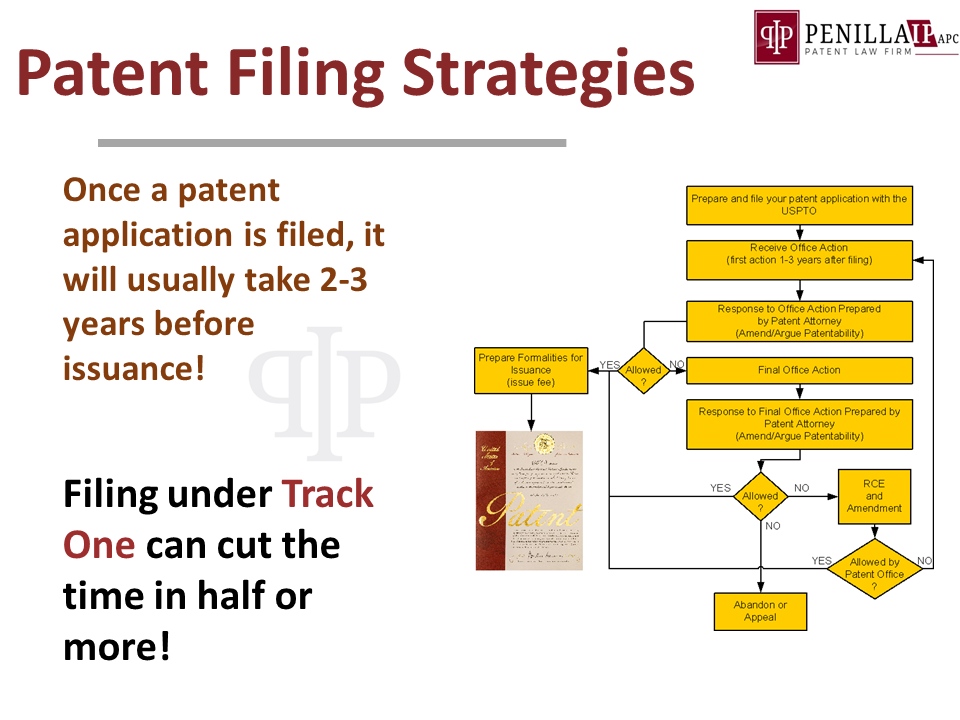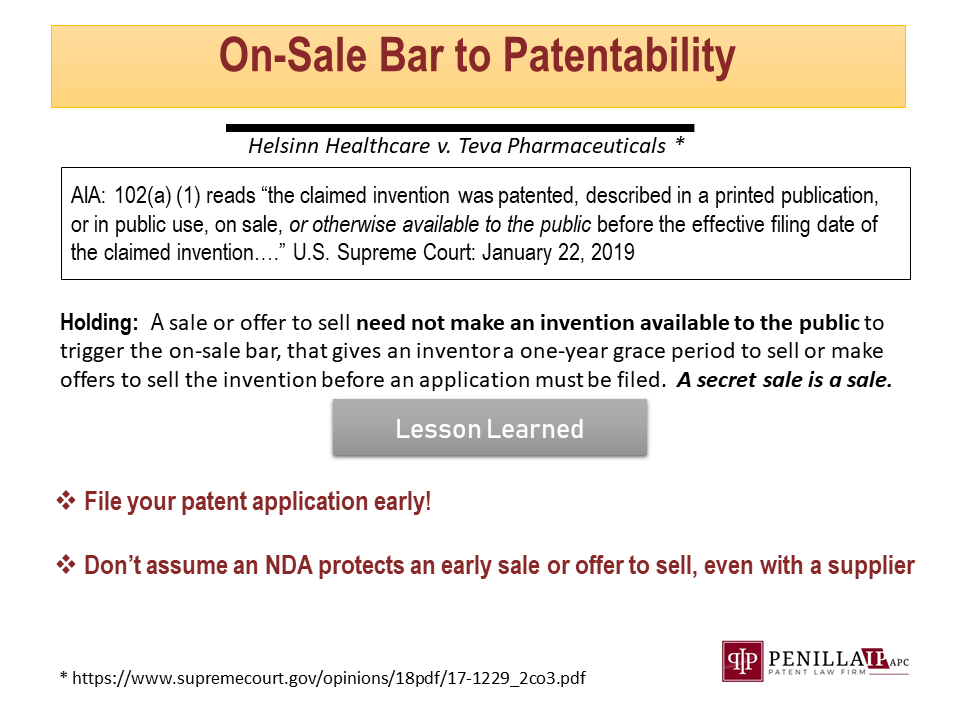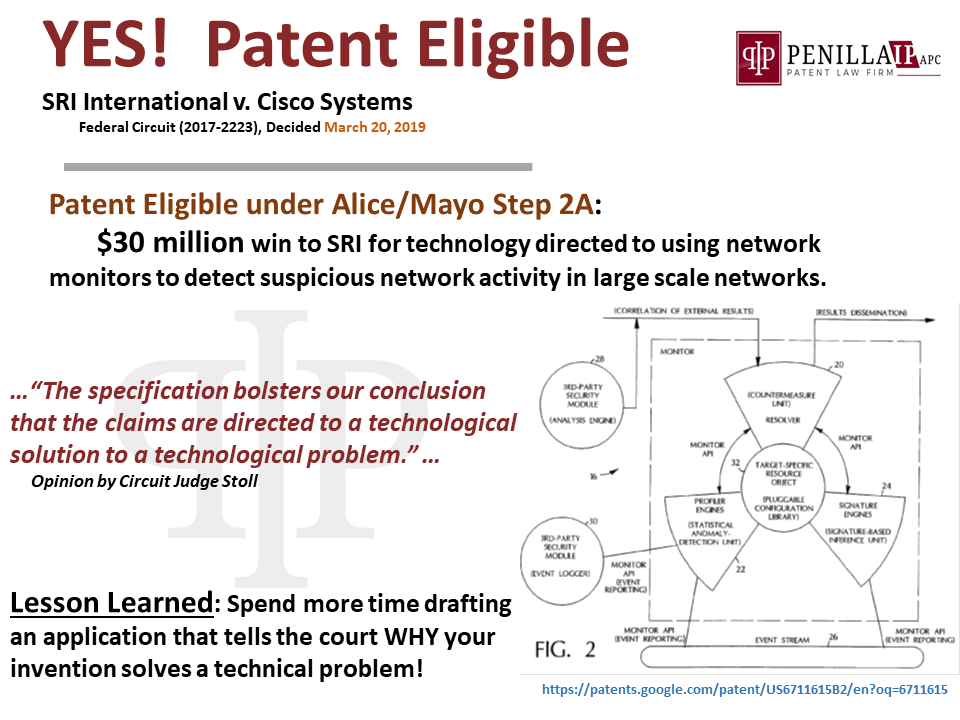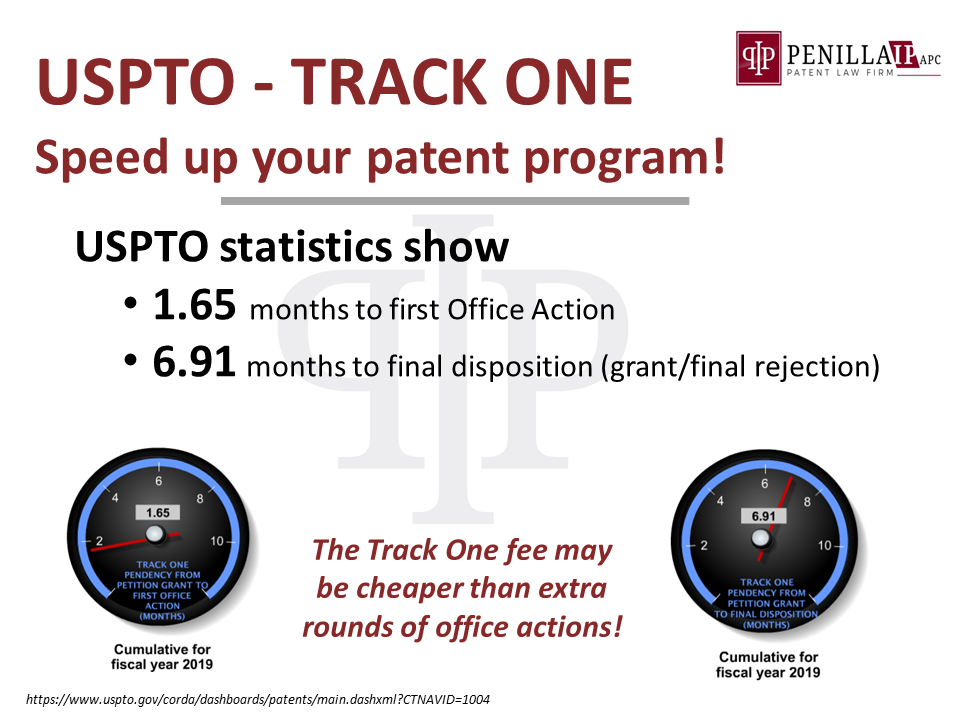
Always consider the process! Although the USPTO’s Track One program charges a larger filing fee, the shorter process may save you more money by avoiding prosecution cycles! For more details, see our site at: https://penillaip.com/patents_fast.cfm

Call Us: 408.749.6900 Client Home

Always consider the process! Although the USPTO’s Track One program charges a larger filing fee, the shorter process may save you more money by avoiding prosecution cycles! For more details, see our site at: https://penillaip.com/patents_fast.cfm

You should file your patent application before disclosure. However, in the US, you have one year grace period to file after disclosure. The disclosure can be a sale or offer to sell. Be extra careful when entering into agreements to commercialize your invention before filing the application, or you will lose your patent!
It is more important than ever to spend more time and effort drafting your patent applications. Here, the Federal Circuit is expressly telling patent owners to spell out the technical problem-solution in the specification! As Circuit Judge Stoll writes, the Federal Circuit will use the patent specification to “bolster” its conclusion. It should be evident that the value of quick and cheap applications is now nearly zero; while the value of quality written and prosecuted patents is rapidly increasing!


Some inventions are worth expediting! But, also consider the cost savings in avoiding extra rounds of prosecution that can take up to four years or more. Recent statistics show that Track One is still a great alternative to speed up the issuance of important innovations. This is key for startups that need to secure funding or large corporations wishing to control costs for important innovations.
Do you really need an NDA?
SORRY, WE DON’T SIGN NON-DISCLOSURE AGREEMENTS (NDAs)! This practice is all too common, and is becoming the norm. Start-ups need to understand that large companies are trained to avoid risk and liabilities. Plainly, they are afraid of the potential liabilities associated with engaging with start-ups that later claim that their inventions were stolen. It is true, many large companies have R&D groups working on many areas of their business, which include future ventures that are not even public. For this reason, corporate lawyers are quick to reduce the risk and instruct business people to not sign NDAs or simply not take meetings with eager start-ups.
As the start-up, we recommend that you understand the position of the large company. Instead of cursing or bad mouthing the inflexibility of large companies, start-ups need to have basic IP tools. These tools come in the form of patent protection. Sure, securing a patent can be expensive. However, there are ways of reducing the time and expense when filing your initial patent application.
Every situation is different, but for start-ups that have innovation that requires world-wide protection, we recommend a two-step process:
Now that you have a provisional patent application on file, the time starts to tick. The provisional patent application is your “local priority application.” In the US, you have 1 year within which to file a non-provisional application. Additionally, if you need protection outside of the US, you can also file a PCT patent application (see diagram above). You may also file a PCT patent application and not file the US non-provisional application until the 30 month date. This may reduce cash flow burn, as that cost can be delayed.
If steps 1 and 2 are done ahead of time, your start-up should feel safer having that all important meeting without an NDA. Of course, you should understand that nothing is risk free, but at least you can feel confident knowing that you have proof of your invention on file.
The lesson here is to understand why large companies don’t sign NDAs, and protect your IP ahead of time with a US provisional patent application and consider PCT filings for international protection. As in anything worthwhile, there is more to know about the mechanics associated with filing patents and PCT filings, but this should give you a general idea of the questions to ask and/or consider when speaking to your patent attorney.
by, Albert S. Penilla
This information is for general information purposes only to permit you to learn more about patents, and is not legal advice and does not create or constitute an attorney-client relationship. Further, this information is not intended as a solicitation, and is not a substitute for securing legal advice from an attorney.
Patent Prosecution for corporate clients – large and small. Whether you are are startup or established corporation, we specialize in custom patent services. We have issued over 5000 US patents and many thousands throughout the world. Contact us to discuss how we can provide you with more value! www.penillaip.com
This is a short tutorial for how to work with a patent attorney when preparing your patent application. This applies to startups, established companies, and individuals. The key is to provide your attorney with as much information as possible, so your application can be comprehensive and be better positioned for strength. Contact us for more information.
https://penillaip.com/patents.cfm
Brief Overview of Process
The preparation of a patent application begins with a good disclosure by the inventor(s). Usually, an inventor writes a document explaining his or her invention. The level of detail may vary, but usually it should be enough detail so that someone having ordinary skill in the particular technology can understand the details. If the inventor works for a company with an established patent program, the disclosure may be well developed. If the inventor is not assisted by a patent professional, the disclosure may require more information.
The application preparation process will generally include a meeting with the inventor(s). It is our goal is to conduct the most comprehensive and complete first disclosure meeting possible. A good first disclosure is key to an efficient preparation process that will reduce the burden on the inventor. If possible, we prefer in-person disclosure meetings, but we also routinely conduct teleconference disclosure meetings and web-based conferences.
Our firm implements specific processes for drafting a patent application to ensure the broadest protection allowable or the protection desired by the client. In drafting the specification, we also ask inventors to provide detailed examples and viable alternatives, which is recommended to ensure that adequate support is provided for each claim term. We also take pride in drafting claims that not only cover our client’s invention, but also provide adequate scope with the competition in mind. It is our goal to provide a first draft that is substantially complete, and will be ready for filing without undue revision cycles.
Examiner Interviews are key to moving a patent application to allowance. Preparation is the name of the game, along with being proactive with the Examiner. www.penillaip.com
The 3 phases of patent preparation. Inventors–don’t let the process overwhelm you. Your goal should be to focus on your invention and let your patent pro guide you through the process! Contact us for details. www.penillaip.com
PENILLA IP is a boutique patent law firm. www.penillaip.com Our group of professionals is highly skilled in the art of patent prosecution. Our consistent high quality work product has made us a “go-to” firm for many of Silicon Valley’s well known technology companies. We also have an established international patent practice, which is highly regarded by our client companies in Asia, Europe and throughout the world.